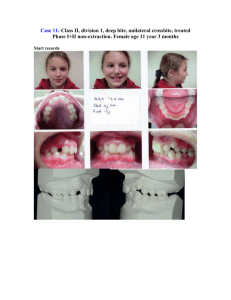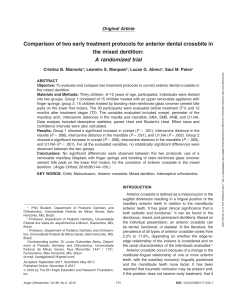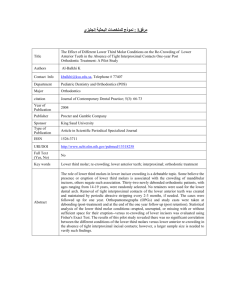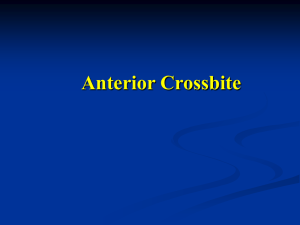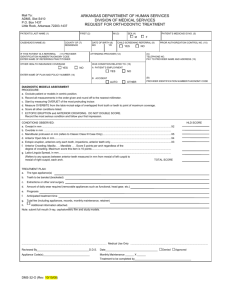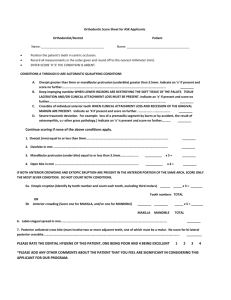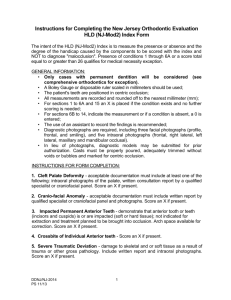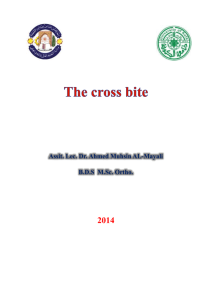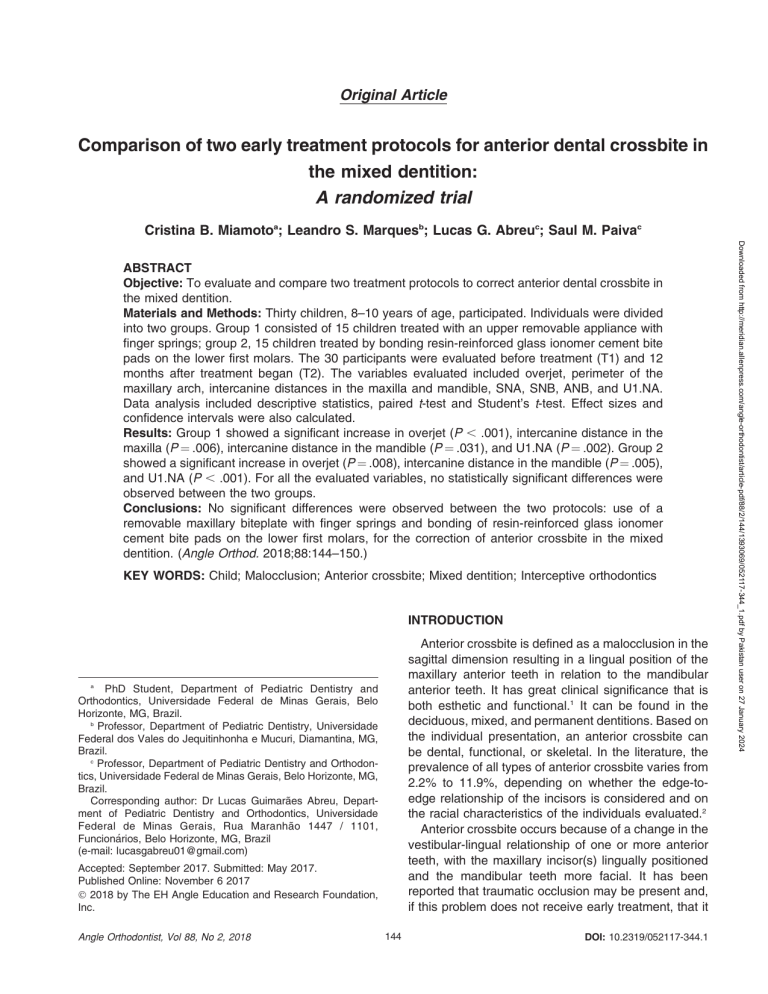
Original Article Comparison of two early treatment protocols for anterior dental crossbite in the mixed dentition: A randomized trial Cristina B. Miamotoa; Leandro S. Marquesb; Lucas G. Abreuc; Saul M. Paivac KEY WORDS: Child; Malocclusion; Anterior crossbite; Mixed dentition; Interceptive orthodontics INTRODUCTION Anterior crossbite is defined as a malocclusion in the sagittal dimension resulting in a lingual position of the maxillary anterior teeth in relation to the mandibular anterior teeth. It has great clinical significance that is both esthetic and functional.1 It can be found in the deciduous, mixed, and permanent dentitions. Based on the individual presentation, an anterior crossbite can be dental, functional, or skeletal. In the literature, the prevalence of all types of anterior crossbite varies from 2.2% to 11.9%, depending on whether the edge-toedge relationship of the incisors is considered and on the racial characteristics of the individuals evaluated.2 Anterior crossbite occurs because of a change in the vestibular-lingual relationship of one or more anterior teeth, with the maxillary incisor(s) lingually positioned and the mandibular teeth more facial. It has been reported that traumatic occlusion may be present and, if this problem does not receive early treatment, that it a PhD Student, Department of Pediatric Dentistry and Orthodontics, Universidade Federal de Minas Gerais, Belo Horizonte, MG, Brazil. b Professor, Department of Pediatric Dentistry, Universidade Federal dos Vales do Jequitinhonha e Mucuri, Diamantina, MG, Brazil. c Professor, Department of Pediatric Dentistry and Orthodontics, Universidade Federal de Minas Gerais, Belo Horizonte, MG, Brazil. Corresponding author: Dr Lucas Guimarães Abreu, Department of Pediatric Dentistry and Orthodontics, Universidade Federal de Minas Gerais, Rua Maranhão 1447 / 1101, Funcionários, Belo Horizonte, MG, Brazil (e-mail: lucasgabreu01@gmail.com) Accepted: September 2017. Submitted: May 2017. Published Online: November 6 2017 Ó 2018 by The EH Angle Education and Research Foundation, Inc. Angle Orthodontist, Vol 88, No 2, 2018 144 DOI: 10.2319/052117-344.1 Downloaded from http://meridian.allenpress.com/angle-orthodontist/article-pdf/88/2/144/1393069/052117-344_1.pdf by Pakistan user on 27 January 2024 ABSTRACT Objective: To evaluate and compare two treatment protocols to correct anterior dental crossbite in the mixed dentition. Materials and Methods: Thirty children, 8–10 years of age, participated. Individuals were divided into two groups. Group 1 consisted of 15 children treated with an upper removable appliance with finger springs; group 2, 15 children treated by bonding resin-reinforced glass ionomer cement bite pads on the lower first molars. The 30 participants were evaluated before treatment (T1) and 12 months after treatment began (T2). The variables evaluated included overjet, perimeter of the maxillary arch, intercanine distances in the maxilla and mandible, SNA, SNB, ANB, and U1.NA. Data analysis included descriptive statistics, paired t-test and Student’s t-test. Effect sizes and confidence intervals were also calculated. Results: Group 1 showed a significant increase in overjet (P , .001), intercanine distance in the maxilla (P ¼ .006), intercanine distance in the mandible (P ¼ .031), and U1.NA (P ¼ .002). Group 2 showed a significant increase in overjet (P ¼ .008), intercanine distance in the mandible (P ¼ .005), and U1.NA (P , .001). For all the evaluated variables, no statistically significant differences were observed between the two groups. Conclusions: No significant differences were observed between the two protocols: use of a removable maxillary biteplate with finger springs and bonding of resin-reinforced glass ionomer cement bite pads on the lower first molars, for the correction of anterior crossbite in the mixed dentition. (Angle Orthod. 2018;88:144–150.) EARLY TREATMENT OF ANTERIOR CROSSBITE IN THE MIXED DENTITION MATERIALS AND METHODS This study is reported according to the Consolidated Standards of Reporting Trials (CONSORT) guidelines.11 Participants, Study Location, and Eligibility Criteria The sample consisted of 30 individuals 8–10 years of age who presented with anterior crossbite in the mixed dentition. The participants were divided into two groups. Group 1 consisted of 15 children who were treated with an upper removable appliance with finger springs. Group 2 consisted of 15 children treated by bonding resin-reinforced glass ionomer cement bite pads on the lower first molars. The distribution of the 30 individuals into the two groups was performed in a randomized manner as follows: a sealed envelope was prepared with 30 cards containing the names of the two treatment protocols on 15 cards each. For each participant, one card was drawn from the envelope to indicate to which group the patient would be assigned. This process was carried out by an assistant until all patients had been placed in a group. The 30 children were treated by one orthodontist. The sample was selected from the medical records of patients receiving treatment at the Children’s Clinic of the Federal University of the Valleys of Jequitinhonha and Mucuri (UFVJM), Diamantina, Brazil. The study included individuals from 8 to 10 years of age who presented with an anterior crossbite in the mixed dentition with all four permanent first molars erupted and at least one permanent incisor in crossbite. Exclusion criteria were (1) any compromised condition of the child’s overall health (including craniofacial anomalies and cognitive disorders) according to the child’s medical record and physical examination as reported by the parents, (2) children with functional crossbites, (3) individuals with skeletal anterior crossbites (ANB ,08) or a posterior crossbite associated with the anterior crossbite, (4) children with sucking habits or cessation of a sucking habit within less than 1 year, and (5) individuals with a prior history of orthodontic treatment. Ethical Considerations The study was approved by the UFVJM Human Research Ethics Committee (protocol 525.056). The children and their guardians were informed about the objectives of the study and that their participation was voluntary. For those agreeing to participate, the children and their guardians signed an informed consent form. After 12 months of follow-up, the children who did not exhibit a full correction of the anterior crossbite either continued in treatment or underwent a new type of treatment. Sample Calculation Considering an alpha significance level ¼ 0.05 and a statistical power of 95%, the study required at least nine individuals in each group to detect an average difference of 2.0 mm (63.0) in overjet between the treatment protocols. To compensate for possible losses, six additional participants were included in each group. Therefore, there were 15 individuals assigned to each group (Figure 1). Upper Removable Appliance with Finger Springs The device had two Adams clasps on the permanent first molars, two arrow clasps between the deciduous molars, and a double finger spring adapted to the palatal surfaces of the teeth to be uncrossed, in addition to the labial bow. The posterior region included an occlusal splint in an attempt to obtain sufficient disocclusion to allow for moving the teeth in crossbite. The patients were advised to remove the appliance only to eat or during oral hygiene. Resin-reinforced Glass Ionomer Cement Bite Pads Resin-reinforced glass ionomer cement bite pads (Riva Light Cure, Bayswater, Australia) were placed on the occlusal surface of the mandibular permanent first Angle Orthodontist, Vol 88, No 2, 2018 Downloaded from http://meridian.allenpress.com/angle-orthodontist/article-pdf/88/2/144/1393069/052117-344_1.pdf by Pakistan user on 27 January 2024 may result in periodontal problems in the mandibular incisors,3 the occurrence of pain, changes in the anterior-posterior positioning of the mandible, and development of problems in the temporomandibular joint (TMJ).4,5 Interceptive orthodontic treatment is defined as any procedure that eliminates or reduces the severity of a developing malocclusion.2 Such an intervention during the mixed dentition may allow the clinician to correct an anterior crossbite, thus favoring more harmonious growth of the bones6–8 and perhaps preventing the crossbite to persist in the permanent dentition. In this sense, when the orthodontist acts in an interceptive manner, comprehensive orthodontic treatment with fixed appliances may be simplified or reduced.9 A wide range of treatment protocols can be used to correct an anterior crossbite in the mixed dentition.2 However, there is little evidence to indicate which treatment method is the most efficient.10 Therefore, the present study aimed to compare two of these protocols: an upper removable appliance with finger springs and the bonding of resin-reinforced glass ionomer cement bite pads on the lower first molars. The null hypothesis was that the early treatment of anterior crossbite with either of these two protocols is equally efficient. 145 146 MIAMOTO, MARQUES, ABREU, PAIVA molars. These devices were thick enough to disclude all the anterior teeth, which allowed enough space for the movement of the teeth in crossbite by tongue pressure. Appointments were scheduled every 3–4 weeks for patients in both groups. Treatment for the 30 participants was conducted by an orthodontic specialist. Overjet (Correction of the Crossbite) Evaluated Variables Evaluation of the maxillary arch perimeter was performed with an initial and final plaster model using a brass wire, beginning at the distal surface of the deciduous second molar (or the mesial surface of the permanent first molar), passing around the arch over the contact points of the posterior teeth and incisal edges of the anterior teeth to the distal surface of the The assessor of the outcomes was blinded. The 30 participants were evaluated before treatment (T1) and 12 months after implementation of the protocols (T2). The following outcomes were measured on study casts: Angle Orthodontist, Vol 88, No 2, 2018 The therapeutic effect of the two treatment protocols was evaluated, using a metal ruler, by measuring the overjet increase in millimeters, that is, the difference of overjet between T1 and T2. Perimeter of the Maxillary Arch Downloaded from http://meridian.allenpress.com/angle-orthodontist/article-pdf/88/2/144/1393069/052117-344_1.pdf by Pakistan user on 27 January 2024 Figure 1. Flow chart of the study. EARLY TREATMENT OF ANTERIOR CROSSBITE IN THE MIXED DENTITION Table 1. Characteristics of the Children in Both Groups and Intergroup Comparisons Group 2 Intergroup Comparison Number (%) Number (%) (P Value) 11 (73.3) 04 (26.7) 07 (46.7) 08 (53.3) 0.264* 05 (33.3) 10 (66.7) 08 (53.3) 07 (46.7) 0.462* 07 (46.7) 08 (53.4) 07 (46.7) 08 (53.3) 0.999* Mean (SDa) Mean (SD) Children’s age (years) 9.07 (0.79) Number of teeth crossed 1.60 (1.06) 9.00 (0.84) 1.67 (0.61) Gender Boys Girls Crowding No Yes Full crossbite correction No Yes 0.826** 0.834** a SD indicates standard deviation. * Pearson chi-square test. ** Student’s t-test. deciduous second molar (or the mesial surface of the permanent first molar) on the opposite side.12 The increase in arch perimeter was calculated by the difference between the perimeter of the arch in T1 and T2. position of the maxilla and mandible to each other. The upper incisor inclination (U1.NA) was also evaluated. The change in cephalometric angles was determined by the difference in the values between T1 and T2. Statistical Analysis Statistical analysis was conducted using the Statistical Package for the Social Sciences (SPSS for Windows, version 17.0, SPSS Inc, Chicago, Ill). Application of the Shapiro-Wilk test demonstrated that the data were normally distributed. Therefore, parametric tests were used. The analysis of the data included descriptive tests (chi-square and Student’s ttest) to characterize the sample. Paired t-tests were used to evaluate the effects (changes occurring during treatment, T2T1) of the two treatment protocols for correcting anterior crossbite. A Student’s t-test was used to compare the changes occurring during treatment (T2T1) between the two groups. Values of P , .05 were considered statistically significant. Effect sizes with 95% confidence intervals were also calculated by dividing the difference between the means of both groups by the pooled standard deviation.14,15 Effect sizes were interpreted according to the following values: 0.20, small; 0.50, medium; and 0.80, large.14 Intercanine Distance The intercanine distance in the maxilla and mandible was measured with a digital caliper (Digital 6, 8M007906, Mauser-Messzeug GmbH, Oberndorf/ Neckar, Germany) as the shortest linear distance between the canine cusp tips on the plaster models. Intercanine expansion was calculated by the difference between the intercanine distances at T1 and T2.13 Cephalometric Analysis The cephalometric angles evaluated were SNA, SNB, and ANB, to evaluate the position of the maxilla and mandible relative to the cranial base and the Table 2. Comparison of Pretreatment Measures Between Groups Group 1 Mean (SD) Overjet Arch perimetera Dist IC (Mx) Dist IC (Md) SNA SNB ANB U1.NA 1.13 92.20 42.93 36.80 82.14 78.34 3.80 20.60 (0.35) (6.61) (2.12) (2.04) (3.74) (3.76) (1.74) (4.88) Group 2 Mean (SD) 1.27 90.73 42.20 35.07 81.77 78.42 3.35 19.73 (0.45) (5.24) (3.52) (2.57) (4.41) (4.36) (2.75) (6.11) P Value* .379 .506 .496 .051 .805 .961 .600 .671 a Indicates maxillary arch perimeter; Dist IC (Mx), intercanine distance in the maxilla; Dist IC (Md), intercanine distance in the mandible; SD, standard deviation. * Indicates Student’s t-test. Significance level of P , .05. RESULTS The average age of the children in group 1 was 9.07 years (60.79), while in group 2, it was 9.00 years (60.84). Characteristics of the participants and intergroup comparisons are described in Table 1. Comparison of the pretreatment measures between groups is displayed in Table 2. Table 3 shows the effects (T2T1) of the two treatment protocols for correcting the anterior crossbite. Group 1 showed a significant increase in overjet (P , .001), maxillary intercanine distance (P ¼ .006), mandibular intercanine distance (P ¼ .031), and upper incisor inclination (P ¼ .002). Group 2 showed a significant increase in overjet (P ¼ .008), mandibular intercanine distance (P ¼ .005), and upper incisor inclination (P , .001). Table 4 compares the changes during treatment between the two protocols and the effect sizes. No statistically significant differences were observed between the two groups for any of the variables evaluated. DISCUSSION The orthodontic literature on early treatment protocols for anterior crossbite has been sparse. Recently, a systematic review suggested that clinical trials should be conducted to evaluate the efficiency of different treatment protocols for this type of malocclusion.2 Taking into account the lack of statistically significant Angle Orthodontist, Vol 88, No 2, 2018 Downloaded from http://meridian.allenpress.com/angle-orthodontist/article-pdf/88/2/144/1393069/052117-344_1.pdf by Pakistan user on 27 January 2024 Group 1 147 148 MIAMOTO, MARQUES, ABREU, PAIVA Table 3. Effects of the Two Treatment Protocols in Correcting Anterior Crossbite Group 1 Mean (SD) T1 Overjet Arch perimetera Dist IC (Mx) Dist IC (Md) SNA SNB ANB U1.NA 1.13 92.20 42.93 36.80 82.14 78.34 3.80 20.60 (0.35) (6.61) (2.12) (2.04) (3.74) (3.76) (1.74) (4.88) Group 2 P Value* Mean (SD) T2 0.27 91.73 44.33 38.40 83.20 79.12 4.09 23.87 (0.88) (6.60) (2.71) (2.66) (3.76) (3.69) (2.48) (4.67) ,.001 .250 .006 .031 .114 .276 .589 .002 Mean (SD) T1 1.27 90.73 42.20 35.07 81.77 78.42 3.35 19.73 (0.45) (5.24) (3.52) (2.57) (4.41) (4.36) (2.75) (6.11) Mean (SD) T2 0.27 90.27 43.33 37.27 81.63 78.42 3.21 23.60 (0.96) (5.50) (1.98) (2.37) (4.61) (4.45) (1.46) (5.08) P Value* .008 .396 .084 .005 .794 1.000 .795 ,.001 differences between protocols, the null hypothesis could not be rejected in the present study. Anterior crossbite affecting one or more incisors was corrected efficiently by both an upper removable appliance with finger springs and bonded resin-reinforced glass ionomer cement bite pads on the lower first molars. Thus, both treatment protocols could be recommended for correcting this type of malocclusion. Consequently, this study offers relevant information to practitioners because early treatment of anterior crossbite has been widely advocated.16,17 The findings reported in this study showed that both of the early protocols investigated led to a significant increase in overjet and mandibular intercanine distance after the 12-month treatment period. Moreover, improvement in overjet and intercanine distance in the mandible was not different between the upper removable appliance and the bite pads on the lower first molars. One prior study that compared the efficiency of fixed appliances and upper removable appliances with finger springs demonstrated that an anterior crossbite in the mixed dentition can also be corrected successfully using either of those two protocols.10 Additionally, long-term, posttreatment stability was similar in those two modes of treatment. For both the fixed and the removable appliance, the success rate remained high at the 2-year follow-up.18 One randomized clinical trial that evaluated the early correction of unilateral posterior crossbite revealed that the success rate was superior with a fixed device (Quad-helix) compared with treatment using a removable appliance with an expansion screw.19 The average treatment time was also significantly shorter and cheaper with the bonded device.20 This finding may be attributed to low compliance with the removable device. It is well-known that when therapy with removable appliances is prescribed, patient compliance is a determining factor in the efficiency of treatment.21 The level of compliance with treatment can partly explain the prolonged treatment time observed with removable appliances. However, if the patients had cooperated, perhaps there would have been a more favorable outcome.22 It is likely that patients with anterior crossbite have greater awareness of their malocclusion since the condition is esthetically obvious in contrast to patients with posterior crossbite.18 Hence, the individuals from the current study should have been highly motivated and willing to comply with treatment recommendations. Despite being a nonsignificant difference, the increase in overjet was marginally higher for the Table 4. Comparison of the Changes During Treatment (T2T1) Between the Two Groups Overjet Arch perimetera Dist IC (Mx) Dist IC (Md) SNA SNB ANB U1.NA Group 1 T2T1 Group 2 T2T1 Mean (SD) Mean (SD) 1.40 0.47 1.40 1.60 0.74 3.30 0.29 3.27 (0.91) (1.50) (1.68) (2.58) (2.55) (6.68) (2.05) (3.41) 1.00 0.47 1.13 2.20 0.14 0.40 0.14 3.87 (1.25) (2.06) (2.35) (2.56) (2.03) (1.59) (2.04) (3.14) Difference Between Groups P Value* Effect Size** CI (95%) 0.40 0.00 0.27 0.60 0.88 2.90 0.43 0.60 .326 1.000 .724 .529 .306 .458 .568 .620 0.37 0.00 0.13 0.23 0.38 0.24 0.21 0.18 0.33–1.07 0.70–0.70 0.57–0.83 0.47–0.93 0.32–1.08 0.46–0.94 0.49–0.91 0.52–0.88 a indicates maxillary arch perimeter; Dist IC (Mx), intercanine distance in the maxilla; Dist IC (Md), intercanine distance in the mandible; T1, before treatment; T2, 12 months after beginning treatment; SD, standard deviation; CI, confidence interval. * Student’s t-test. Significance level of P , .05. ** Difference between means of both groups by the pooled standard deviation. Angle Orthodontist, Vol 88, No 2, 2018 Downloaded from http://meridian.allenpress.com/angle-orthodontist/article-pdf/88/2/144/1393069/052117-344_1.pdf by Pakistan user on 27 January 2024 a Indicates maxillary arch perimeter; Dist IC (Mx), intercanine distance in the maxilla; Dist IC (Md), intercanine distance in the mandible; SD, standard deviation; T1, before treatment; T2, 12 months after beginning treatment. * Paired t-test. Significance level of P , .05. EARLY TREATMENT OF ANTERIOR CROSSBITE IN THE MIXED DENTITION and the changes observed from a long-term perspective.10 CONCLUSIONS No significant differences were observed between the two protocols: use of a removable maxillary biteplate with finger springs and bonding of resinreinforced glass ionomer cement bite pads on the lower first molars, for correcting anterior crossbite in the mixed dentition. REFERENCES 1. Tsai HH. Components of anterior crossbite in the primary dentition. ASDC J Dent Child. 2001;68:27–32. 2. Borrie F, Bearn D. Early correction of anterior crossbites: a systematic review. J Orthod. 2011;38:175–184. 3. Eismann D, Prusas R. Periodontal findings before and after orthodontic therapy in cases of incisor cross-bite. Eur J Orthod. 1990;12:281–283. 4. Valentine F, Howitt JW. Implication of early anterior crossbite correction. ASDC J Dent Child. 1970;37:420–427. 5. Vadiakas G, Viazis AD. Anterior crossbite correction in the early deciduous dentition. Am J Orthod Dentofacial Orthop. 1992;102:160–162. 6. Karaiskos N, Wiltshire WA, Odlum O, Brothwell D, Hassard T H. Preventive and interceptive orthodontic treatment needs of an inner-city group of 6- and 9-year-old Canadian children. J Can Dent Assoc. 2005;71:649. 7. Schopf P. Indication for and frequency of early orthodontic therapy or interceptive measures. J Orofac Orthop. 2003;64:186–200. 8. Väkiparta MK, Kerosuo HM, Nyström ME, Heikinheimo KA. Orthodontic treatment need from eight to 12 years of age in an early treatment oriented public health care system: a prospective study. Angle Orthod. 2005;75:344–349. 9. Musich D, Busch MJ. Early orthodontic treatment: current clinical perspectives. Alpha Omegan. 2007;100:17–24. 10. Wiedel AP, Bondemark L. Fixed versus removable orthodontic appliances to correct anterior crossbite in the mixed dentition—a randomized controlled trial. Eur J Orthod. 2015;37:123–127. 11. Schulz KF, Altman DG, Moher D; CONSORT Group. CONSORT 2010 statement: updated guidelines for reporting parallel group randomized trials. J Clin Epidemiol. 2010;63:834–840. 12. Bishara S. Textbook of Orthodontics. 1st ed. Philadelphia: WB Saunders; 2001. 13. Petrén S, Bondemark L. Correction of unilateral posterior crossbite in the mixed dentition: a randomized controlled trial. Am J Orthod Dentofacial Orthop. 2008;133:790.e7– e13. 14. Cohen J. Statistical Power Analysis for the Behavioral sciences. 2nd ed. Hillsdale, NJ: Erlbaum; 1988. 15. Nakagawa S, Cuthill IC. Effect size, confidence interval and statistical significance: a practical guide for biologists. Biol Rev Camb Philos Soc. 2007;82:591–605. 16. Bayrak S, Tunc ES. Treatment of anterior dental crossbite using bonded-composite slopes: case reports. Eur J Dent. 2008;2:303–306. Angle Orthodontist, Vol 88, No 2, 2018 Downloaded from http://meridian.allenpress.com/angle-orthodontist/article-pdf/88/2/144/1393069/052117-344_1.pdf by Pakistan user on 27 January 2024 individuals treated with the upper removable fingerspring appliance compared with those treated with the resin-reinforced glass ionomer cement bite pads. This effect size was 0.37 mm. Indeed, taking into account the analysis of the effect size, the benefit of a particular protocol may be suggested by a small trial such as this one with nonstatistically significant results. It has been advocated that statistical outcomes give relevant information but, sometimes the statistical significance might not reflect the size of the treatment effect.23 The present study had weaknesses that should be acknowledged. This study should have included a control group of individuals with untreated anterior crossbite of the mixed dentition.18 However, this would have been unacceptable for ethical reasons24 and, also, the use of historical control groups has been a subject of much criticism in orthodontic research.25 Second, as previously mentioned, in any removable appliance therapy, patient compliance with treatment is a significant determinant of treatment efficiency. Therefore, one could argue that the present clinical trial may have been sensitive to the risk of the Hawthorne effect, through which the awareness of being evaluated could have had a positive impact on childrens’ behavior.26 Consequently, they may have cooperated better with the prescribed treatment regimen. However, this trial was strengthened by the random allocation of participants and the prospective longitudinal design. The former helped to minimize bias in the assignment of individuals to each treatment protocol, resulting in two groups that were comparable for known or unknown confounding variables.27 The latter allowed investigation of causal associations between the interventions and the outcome.28 The variables included in this study were highly relevant measures for evaluating treatment effectiveness.29,30 Nevertheless, it is important to note that the literature has also advocated that other important aspects of early intervention should be evaluated in mixed dentition treatment. These include cost-benefit31 and complications during treatment (displacement, breakage, and loss of appliances),20 in addition to other variables, such as the perception of pain and discomfort associated with treatment.32 Those outcomes should be analyzed in future studies. Patientreported measures, such as quality of life assessments have been underrepresented in orthodontic clinical trials. Thus, future research should evaluate individuals’ perceptions of the physical and psychological consequences of such orthodontic protocols.33 Moreover, as the early treatment of anterior crossbite is performed in individuals who are still growing, it is also important to evaluate the stability after correction 149 150 Angle Orthodontist, Vol 88, No 2, 2018 26. McCambridge J, Witton J, Elbourne DR. Systematic review of the Hawthorne effect: new concepts are needed to study research participation effects. J Clin Epidemiol. 2014;67:267– 277. 27. Juni P, Altman DG, Egger M. Systematic reviews in health care: assessing the quality of controlled clinical trials. BMJ. 2001;323:42–46. 28. Levin KA. Study design VII. Randomised controlled trials. Evid Based Dent. 2007;8:22–23. 29. Hagg U, Tse A, Bendeus M, Rabie AB. A follow-up study of early treatment of pseudo Class III malocclusion. Angle Orthod. 2004;74:465–472. 30. Ward DE, Workman J, Brown R, Richmond S. Changes in arch width. A 20-year longitudinal study of orthodontic treatment. Angle Orthod. 2006;76:6–13. 31. Wildel AP, Norlund A, Petrén S, Bondemark L. A cost minimization analysis of early correction of anterior crossbite— a randomized controlled trial. Eur J Orthod. 2016;38:140–145. 32. Wiedel AP, Bondemark L. A randomized controlled trial of self-perceived pain, discomfort, and impairment of jaw function in children undergoing orthodontic treatment with fixed and revovable appliances. Angle Orthod. 2016;86:324– 330. 33. Tsichlaki A, O’Brien K. Do orthodontic research outcomes reflect patient values? A systematic review of randomized controlled trials involving children. Am J Orthod Dentofacial Orthop. 2014;146:279–285. Downloaded from http://meridian.allenpress.com/angle-orthodontist/article-pdf/88/2/144/1393069/052117-344_1.pdf by Pakistan user on 27 January 2024 17. Ulusoy AT, Bodrumiu EH. Management of anterior dental crossbite with removable appliances. Contemp Clin Dent. 2013;4:223–226. 18. Wiedel AP, Bondemark L. Stability of anterior crossbite correction: a randomized controlled trial with a 2-year followup. Angle Orthod. 2015;85:189–195. 19. Petrén S, Bjerklin K, Bondemark L. Stability of unilateral posterior crossbite correction in the mixed dentition: a randomized clinical trial with a 3-year follow-up. Am J Orthod Dentofacial Orthop. 2011;139:e73–e81. 20. Godoy F, Godoy-Bezerra J, Rosenblatt A. Treatment of posterior crossbite comparing 2 appliances: a communitybased trial. Am J Orthod Dentofacial Orthop. 2011;139:e45– e52. 21. Tsomos G, Ludwing B, Grossen J, Pazera P, Gkantidis N. Objective assessment of patient compliance with removable orthodontic appliances: a cross-sectional cohort study. Angle Orthod. 2014;84:56–61. 22. Casutt C, Pancherz H, Gawora M, Ruf S. Success rate and efficiency of activator treatment. Eur J Orthod. 2007;29:614– 621. 23. Faraone SV. Interpreting estimates of treatment effects: implications for managed care. P T. 2008;33:700–711. 24. Pithon MM. Importance of the control group in scientific research. Dental Press J Orthod. 2013;18:13–14. 25. Papageorgiou SN, Koretsi V, Jager A. Bias from historical control groups used in orthodontic research: a metaepidemiological study. Eur J Orthod. 2016;39:98–105. MIAMOTO, MARQUES, ABREU, PAIVA
